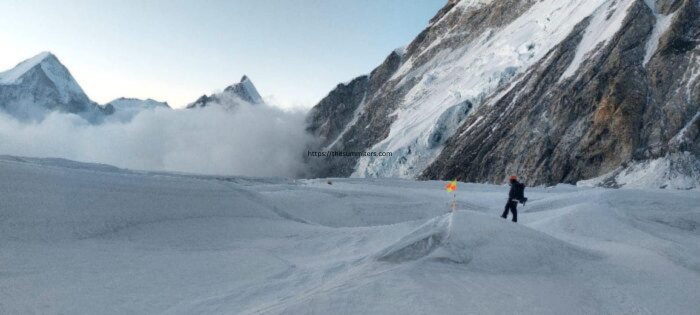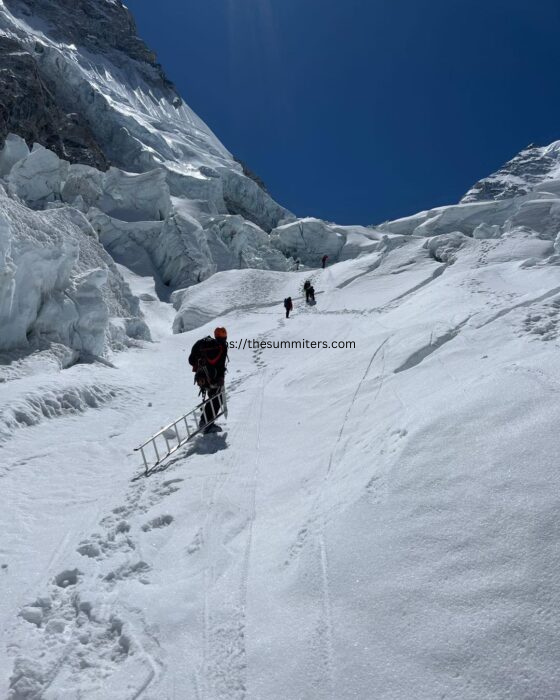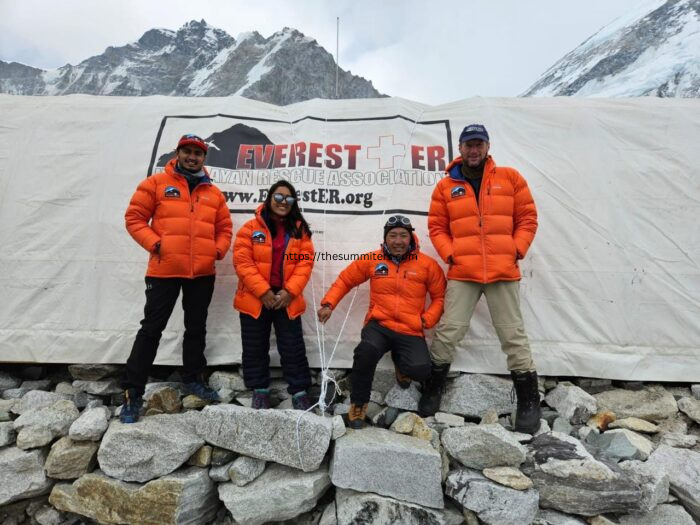Good news: the path through the Khumbu Icefall, is finally clear. Many workers are hauling gear up to set up Camps 1 and 2. However, this route through the Icefall is particularly dangerous right now, so it’s crucial to move through it swiftly.
A dedicated team of Ice Doctors, including Ang Sarki Sherpa, Dawa Nuru Sherpa, and others, worked tirelessly to ensure the route’s safety. It wasn’t easy; they had to make three attempts due to the challenging conditions.

Last winter was unusually dry, resulting in minimal snow cover and unstable ice formations, making the Khumbu Icefall even more hazardous than usual. There are numerous large ice blocks, known as seracs, which create obstacles along the route. Additionally, the section near the West Shoulder is especially risky due to the abundance of seracs.
The Ice Doctors will inspect the route daily and address any issues promptly. However, they urge everyone to take extra precautions:

Only one person should use a ladder at a time.
High-altitude workers should lighten their loads to prevent overloading the ladders.
Always secure your harness to safety ropes when using ladders.
Helicopter Flights: A Tempting Option with Limits
In the current circumstances, as a large number of climbers are expected, there’s a strong temptation to opt for helicopter flights to Camp 2. However, local authorities have strict regulations permitting helicopters only for rescue operations and transporting essential gear such as ropes and anchors— not for supplying camps or, especially, climbers themselves.
This year, Sherpas will be tasked with setting up routes not only on Everest and Lhotse but also on Nuptse. Madison Mountaineering has a commercial group on Nuptse, standing at 7,861 meters, currently without other climbers.
Meanwhile, Asian Trekking is gearing up to take on Pumori. American ultrarunners Tyler Andrews and Chris Fisher will attempt a speed record, while other climbers will embark on the ascent in the usual manner.
According to Garrett Madison’s update to ExplorersWeb, the delays haven’t caused any issues for the majority of his clients: “Since we’re starting our journey a bit later than other teams, the hold-up doesn’t impact us,” he clarified.
During this extra time, other teams have been making the most of it by honing their ice climbing skills around the Khumbu Glacier or adjusting to higher altitudes on nearby trekking peaks. To minimize risks, commercial teams are strategizing to reduce the number of times their clients need to navigate the Icefall. For those planning to use bottled oxygen from Camp 2, they may only need to traverse it twice—once for an initial trip to Camp 2 and then again for the final summit attempt.
Before embarking on their first ascent through the Icefall, most teams are commemorating the event with traditional puja ceremonies.
Climbers Without Oxygen Tanks
The delay poses a bigger challenge for the high-altitude workers and those planning to reach the summit without extra oxygen. They’ll have to make multiple trips up and down the mountain if they’re also opting to climb without personal sherpa assistance and set up their own camps.
Some of these climbers include Hugo Ayaviri from Bolivia, who aims to reach Camp 2 next week, Valery Babanov from Russia, Frank Loke from Norway, Tunc Findik from Turkey, and Norrdine Nouar from Germany.
Nouar, aged 36, recently conquered Annapurna without using extra oxygen. He’s known for his quiet, solo climbs and has experience in various mountain ranges, from the Alps to the Caucasus. Last year he achieved his first summit of an 8,000 meter peak Lhotse without extra oxygen. According to the Himalayan Database, he was the sole climber to achieve this feat last year.
“For me, using extra oxygen changes the essence of the mountain. I don’t even carry emergency oxygen,” Nouar explained.
He sees Everest without oxygen not just as a lifelong dream but as part of a learning journey that could lead him to more challenging ascents on other 8,000-meter peaks in an alpine style. On Everest, he plans to climb as independently as possible, relying on fixed ropes but carrying his own tent and equipment.
Everest Base Camp Clinic Fully Operational
Even though climbers haven’t started their rotations yet, the team at the Everest ER clinic has been bustling since their arrival.

“We’ve already treated over 100 patients in just 10-11 days,” reported Dr. Nishant Joshi to ExplorersWeb. Nearly all of them are the dedicated individuals who tirelessly support expedition teams.